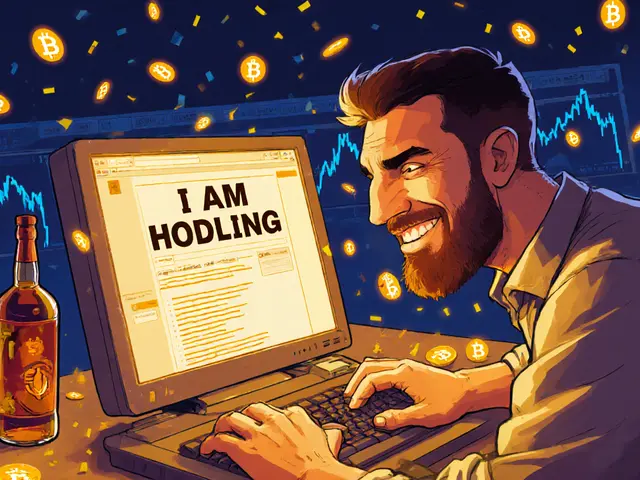What Does HODL Mean in Cryptocurrency? The Full Story Behind the Term

HODL Value Calculator
See the Power of Long-Term Holding
Calculate how your investment would have performed if you'd held Bitcoin during key market events. Based on historical data from the article.
Your Potential Returns
HODL StrategyEnter your investment details above
This shows potential value if you held through volatility
"HODLing isn't about being right every day. It's about being right over ten years."
Remember: The HODL strategy works best for assets with real scarcity like Bitcoin. Never invest more than you can afford to lose.
When you hear someone say they’re "HODLing" their Bitcoin, they’re not talking about a new type of wallet or a secret trading technique. They’re saying they’re HODLing - holding on, no matter what. It’s one of the most powerful ideas in crypto, born from a drunken typo on a forum in 2013. Today, it’s a movement. A mindset. A way of surviving the wildest asset class on earth.
The Origin: A Typo That Changed Crypto
It started on December 18, 2013. BitcoinTalk, the old-school forum where early adopters gathered, was buzzing. Bitcoin had just hit $1,200 - then crashed hard. One user, GameKyuubi, typed a post while clearly drunk. He meant to write: "I am holding." But he hit the wrong key. His post said: "I AM HODLING." He didn’t sell. He didn’t panic. He doubled down. "I have a lot of alcohol in me and I'm not selling my BTC for anything less than 10k," he wrote. The typo stuck. People laughed. Then they copied it. Then they turned it into a mantra. Soon, "HODL" became more than a mistake. It became a badge. A symbol of resilience. Later, the community backronymed it: "Hold On for Dear Life." And it fit. Because in crypto, life feels like it’s hanging by a thread during every crash.What HODLing Actually Means
HODLing isn’t just buying crypto and forgetting about it. It’s a deliberate, emotional strategy. You buy. You store it in your own wallet - not on an exchange. And then you ignore the price. No matter if Bitcoin drops 30% in a day. Or 75% over six months. You don’t sell. You don’t check the chart every hour. You don’t read the doom posts on Reddit. It’s the opposite of day trading. Day traders watch candles, use indicators, chase momentum. HODLers don’t care. They believe in the long-term value of the asset. For Bitcoin, that’s simple: it’s limited. Only 21 million will ever exist. Every four years, new supply gets cut in half. That’s scarcity. That’s why people think it could be digital gold. HODLing requires almost zero technical skill. You need a wallet. You need to send your coins there. And you need to keep your private keys safe. That’s it. No complex charts. No leverage. No margin calls. Just patience.Why People HODL - And Why It Works
Look at the numbers. In 2017, Bitcoin jumped from $1,000 to nearly $20,000. The people who bought at $1,000 and held? They made 1,900%. The people who traded in and out? A 2018 University of California study found they lost 36% on average. Why? Because they sold low and bought high - the exact opposite of what you should do. HODLers missed the short-term swings. But they caught the big wave. Bitcoin’s 2021 peak? $69,000. The 2022 crash? Down to $15,000. Then it bounced back. HODLers who held through that 75% drop? They’re up again. Those who panicked and sold at $15,000? They’re still down. It’s not magic. It’s math. And psychology. Most traders lose because they react to fear and greed. HODLers train themselves to ignore both. The crypto community calls those who hold through the worst times "diamond hands." The ones who fold? "Paper hands."
The Dark Side: When HODLing Goes Wrong
HODLing isn’t a free pass. It’s not "buy and wait for riches." It’s "buy and wait - and suffer." Take Ethereum in 2018. It dropped from $1,400 to $85. Took 22 months to recover. If you HODLed through that? You lost 94% of your money. For a year and a half. That’s not just painful. It’s life-changing. And not all coins are Bitcoin. Thousands of altcoins were created. Most have no real use. No adoption. No team. Just hype. If you HODLed Dogecoin in 2021? You rode the rocket. But if you HODLed a coin that vanished? You lost everything. Nobel Prize-winning economist Paul Krugman called HODLing "speculative bubble behavior." He’s not wrong. If you buy something just because you think someone else will pay more later - with no intrinsic value - that’s speculation. HODLing works best when you believe in the asset’s fundamentals. Not just the price chart.How to HODL Properly
If you want to HODL, don’t just jump in. Do it right.- Buy only what you can afford to lose. Crypto can go to zero. Seriously. Most altcoins already have.
- Use your own wallet. Never leave coins on an exchange. Exchanges get hacked. Exchanges get shut down. Your keys = your coins.
- Write down your private key. On paper. In a safe place. 20% of all Bitcoin is already lost - because people forgot their passwords or lost their drives.
- Set a clear reason for buying. Is it because you believe in Bitcoin as digital gold? Because you think it’ll replace gold? Because you trust the code? Write it down. When the market crashes, read it again.
- Don’t check the price daily. One study found 63% of long-term holders had severe anxiety during 50%+ drops. Ignoring it isn’t denial. It’s strategy.
HODL vs. Other Strategies
HODL isn’t the only way. But it’s the simplest.- Day trading: Requires hours of analysis, emotional control, and constant attention. 90% of day traders lose money.
- Staking: Earn interest on your crypto by locking it up. But you risk smart contract bugs or slashing penalties.
- Yield farming: High returns - but high risk. Many DeFi projects have vanished overnight.

Who’s Doing It Right?
Michael Saylor, CEO of MicroStrategy, turned his company into a Bitcoin HODLing machine. He bought over 214,000 Bitcoin. Called it "the highest-return, lowest-risk asset for corporate treasury." He’s betting everything on Bitcoin’s long-term value. Institutional investors are catching on. Fidelity found that 45% of institutional investors now use some form of HODL strategy - up from 12% in 2020. Grayscale’s Bitcoin Trust grew from $2.2 billion to $28.6 billion in just two years. That’s not trading. That’s HODLing at scale. Even the U.S. government helps. The IRS treats crypto as property. If you hold for over a year, you pay lower capital gains tax - max 20%. If you trade every week? You pay up to 37%. HODLing saves you money. Legally.The Future of HODL
The original HODL was pure. Buy. Hold. Ignore. Now, people are mixing it. "Strategic HODLing" means holding most of your coins, but selling small portions to lock in profits. A 2023 CryptoQuant report found 62% of long-term Bitcoin holders now do this. It’s not pure HODL. But it’s smarter. BlackRock’s push for a Bitcoin spot ETF could bring trillions in new money. That’s not traders. That’s institutions. That’s HODLers. They don’t flip. They accumulate. The bottom line? HODLing isn’t going away. As Bitcoin’s supply gets tighter - only 2.4 million coins left to mine - scarcity will grow. The people who held through the crashes? They’ll be the ones holding the most. It’s not about being right every day. It’s about being right over ten years.FAQ
Is HODLing still a good strategy in 2025?
Yes - but only for assets with real scarcity and adoption, like Bitcoin. HODLing works best when you believe in the long-term value of the asset, not just its price. For altcoins with no use case or team, HODLing is risky. A 2023 survey of 100 crypto professionals found 79% believe the core idea of long-term holding will grow stronger, even if the pure "HODL" meme fades.
Can I HODL on an exchange?
Technically, yes - but you shouldn’t. Exchanges are targets for hackers, bankruptcies, and government seizures. If you don’t control your private keys, you don’t own your coins. True HODLing means moving your crypto to a personal wallet - hardware or software - that only you can access.
What’s the difference between HODL and buy and hold?
There’s no real difference. "Buy and hold" is the traditional finance term. "HODL" is the crypto version - born from a meme, but now used the same way. Both mean holding an asset long-term despite short-term price swings. HODL just carries more emotional weight in crypto culture.
How long should I HODL crypto?
There’s no fixed timeline. Most serious HODLers plan for 5 to 10 years. Bitcoin’s halving cycles happen every four years - that’s a good rhythm to watch. If you bought at $10,000 and it’s now $60,000, you’ve already won. But if you’re holding for the next bull run, you need to be ready for another 50-80% drop. The longer you hold, the more likely you are to benefit from compounding adoption.
What happens if I forget my wallet password?
Your crypto is gone forever. There’s no reset button. No customer support. That’s the whole point of decentralization. A 2022 Chainalysis report estimates 3.8 million Bitcoin - worth over $76 billion - are permanently lost because people lost their keys or forgot passwords. Always back up your recovery phrase. Store it offline. In multiple places. Treat it like your will.
